NORTHBROOK, Ill., Nov. 8, 2017 /PRNewswire/ -- Allstate released a new survey today revealing that more than a third (35 percent) of U.S. drivers say wet winter driving stresses them out, and almost half (48 percent) are concerned by the prospecti — all while the National Oceanic and Atmospheric Administration is predicting an especially wet winter for much of the country.
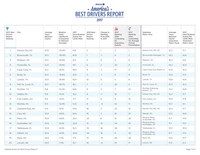
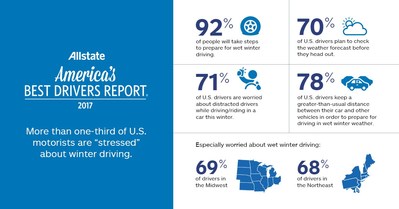
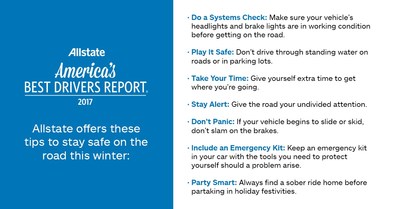
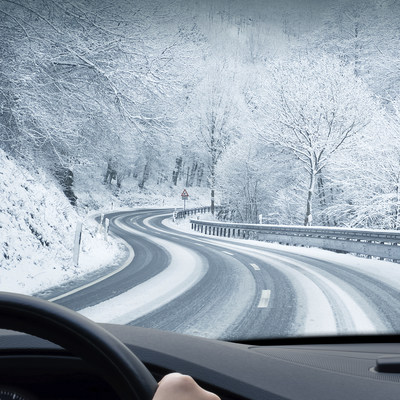
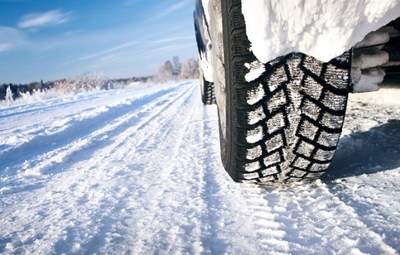
The Allstate winter-driving survey is being released in conjunction with the 2017 Allstate America's Best Drivers Report®ii winter data, which ranks the top 200 cities with the safest drivers when rain and snow are part of the equation. Coming in as the safest-driving city when factoring in precipitation is Kansas City, Kansas, reclaiming its top spot from two years ago.
"As part of Allstate's safe-driving legacy, we're shining a light on our country's safest drivers and helping communities across the country stay vigilant on the road, especially during winter and the holiday travel season," said Glenn Shapiro, Allstate's chief claims officer. "Just as you would grab an umbrella or coat when heading out the door, Allstate encourages everyone to take the appropriate precautions to ensure they arrive at their destinations safely."
Those precautions are especially important for drivers this winter, with NOAA predicting wetter-than-average conditions across most of the northern United States in its recently released annual Climate Prediction Center's U.S. Winter Outlook.iii
To determine the precipitation-based rankings, Allstate researchers use a predictive model that standardizes the rankings to account for the fact that weather conditions affect road safety and vary dramatically across the United States. Allstate is recognizing the cities that topped the report and offering tips to help people across the country drive safely.
The top 10 safest-driving cities when precipitation and collisions are taken into account:
| City & Average Annual |
NOAA 30-Year |
Average Years |
Ranking After |
| 1. Kansas City, Kansas |
39.1 |
14.9 |
3 |
| 2. Brownsville, Texas |
27.4 |
14.5 |
4 |
| 3. Huntsville, Alabama |
54.3 |
12.4 |
33 |
| 4. Cape Coral, Florida |
55.9 |
12.2 |
17 |
| 5. Port St. Lucie, Florida |
63.7 |
12.0 |
20 |
| 6. Madison, Wisconsin |
37.3 |
12.5 |
2 |
| 7. Olathe, Kansas |
41.9 |
11.8 |
13 |
| 8. Laredo, Texas |
20.2 |
12.0 |
5 |
| 9. Boise, Idaho |
11.7 |
12.0 |
6 |
| 10. McAllen, Texas |
19.5 |
11.8 |
7 |
While the Allstate survey found that only a quarter (26 percent) of American drivers feel confident in their winter driving abilities, a resounding 92 percent take active steps to better prepare themselves for slick roads, including increasing following distance behind another vehicle (78 percent) and checking the weather before heading out (70 percent). According to NOAA, preparations like these are key to navigating potentially harsh conditions.
"NOAA shares advanced seasonal outlooks to help communities prepare for what's likely to come in the next few months and minimize the winter weather's impact on lives and livelihoods," said Mike Halpert, deputy director of NOAA's Climate Prediction Center. "Empowering people with actionable forecasts and winter weather tips is key to NOAA's efforts in building a weather-ready nation."
To help keep precipitation from causing a collision, Allstate offers these tips:
- Do a systems check: Make sure your headlights and brake lights are in working condition, along with tires, heater, defroster, brakes and windshield wipers, and that you have enough windshield washer fluid.
- Play it safe: Don't drive through standing water on roads or in parking lots — it can stall your engine. Take an alternate route.
- Take it easy: Give yourself extra time to get where you're going. Increasing following distance, traveling at slower speeds and accounting for the extra stopping time will help avoid collisions.
- Stay alert: Give the road your undivided attention. That's especially important with slick streets and potentially dangerous conditions.
- Don't panic: If your vehicle begins to slide or skid, don't slam on the brakes. Look down the road in the direction you want to go and gently steer your vehicle that way. Release the accelerator until traction returns.
- Have an emergency kit: Include the tools you will need to protect yourself should a problem arise. Gloves, boots, blankets, flares, water, jumper cables, a flashlight and something for traction, such as sand or cat litter, are all helpful items to have in the car.
- Party smart: Especially during the busy holiday travel season, including one of the most deadly days on the road — New Year's Dayiv — Allstate strongly urges drivers to plan ahead and always find a sober ride home before partaking in holiday festivities.
For more than a decade, Allstate has been leading the conversation about safe driving, with efforts like its America's Best Drivers Report and the Reality Rides® driving simulator designed to educate communities on this important issue while celebrating the drivers already doing their part to keep roads safe.
Visit Allstate.com/BestDriversReport for an interactive map and full results for this year, as well as rankings in previous years' reports. For more safe-driving tips and information, visit The Allstate Blog or contact an Allstate agency owner.
About Allstate
The Allstate Corporation (NYSE: ALL) is the nation's largest publicly held personal lines insurer, protecting approximately 16 million households from life's uncertainties through auto, home, life and other insurance offered through its Allstate, Esurance, Encompass and Answer Financial brand names. Allstate is widely known through the slogan "You're In Good Hands With Allstate®." Allstate agencies are in virtually every local community in America.
_______________________________________
i The 2017 Allstate Wet Winter Weather Driving survey was conducted by YouGov Plc from October 27-30, 2017. The survey was conducted online among 1,189 adults. The figures have been weighted and are representative of all US adults (aged 18+).
ii The Allstate America's Best Drivers Report® tabulates property damage frequency of Allstate insured drivers from 2013-2014. The report analyzes the 200 largest cities from the U.S. Census Bureau's Annual Estimates of the Population for Incorporated Places over 50,000, measured for 2014 as of July 1, 2015. In prior years, neighboring cities that shared zip codes also shared rankings. This only impacted a minimal number of cities; however, since 2014, the report used geolocation to increase accuracy and there are no longer shared rankings. U.S. Census Bureau estimates of land area were combined with population estimates to determine population density. The Allstate Best Drivers Report is produced solely to boost the country's discussion about safe driving and to increase awareness of the importance of being safe and attentive behind the wheel. The report is not used to determine auto insurance rates.
iii National Oceanic and Atmospheric Administration, U.S. Winter Outlook: NOAA forecasters predict cooler, wetter North and warmer, drier South
iv 2016, Insurance Institute for Highway Safety: www.iihs.org
SOURCE Allstate Insurance Company
Related Links
WANT YOUR COMPANY'S NEWS FEATURED ON PRNEWSWIRE.COM?
Newsrooms &
Influencers
Digital Media
Outlets
Journalists
Opted In
Share this article